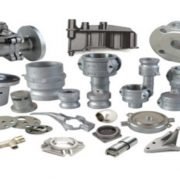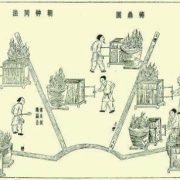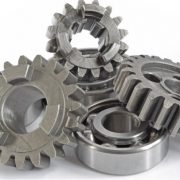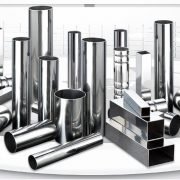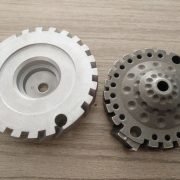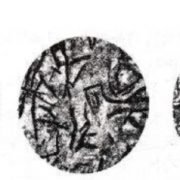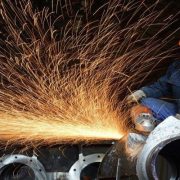How to Effectively Eliminate the Magnetism of Stainless Steel Castings
/0 Comments/in Yide casting article/by Yide CastingHow to Effectively Eliminate the Magnetism of Stainless Steel Castings
The stainless steel castings become magnetic when containing martensite, austenite or iron elements. But if the stainless steel is magnetic, it will affect its use. Today, let’s see how to effectively remove the magnetism of the casting.
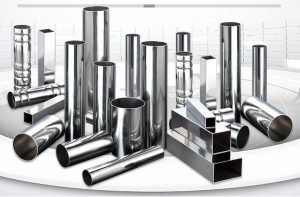
1. Strictly control the equivalent chemical composition
In order to reduce costs, general manufacturers control the lower limit of Ni to between 8.0-8.2%. When Cr/Ni reaches a certain value, a certain amount of ferrite appears in the structure of the steel. While ferrite is magnetic. At this time, 1050 ~1080 solid solution treatment can completely dissolve ferrite into austenite, and then the stainless steel castings will not be magnetic.
2. Cold work hardening
The stainless steel castings will produce deformed martensite during cold working. The deformed martensite increases the strength of the stainless steel. However, the deformed martensite is magnetic. Solution treatment or even annealing can make the deformed martensite disappear, but the strength of the steel will decrease correspondingly.
3. If you want to ensure the strength of cold working, but also weak or even non-magnetic, you can use the following demagnetization methods:
According to the phase diagram principle, reduce the Cr/Ni value, especially increase the Ni and Mn content to the upper limit. Carried out the upper limit solution treatment before cold working, and control the grain size at 4 levels under the premise of ensuring the surface. This can reduce the magnetic properties after cold working. Generally, 304 stainless steel has a certain degree of weak magnetic properties after cold working. However, after beating or another impact, the austenite structure is transformed into martensite, which will have certain magnetic properties. And then heated to 1050 degrees, then water quenching thus can eliminate magnetism.
Yide casting is a professional cast iron factory in China, known as quality gray iron cast, ductile cast iron and brass cast iron, we also have cooperated stainless iron casting and machining factory, all of us have enough ability to provide the best quality casting parts according to your parameters, if you are looking for a quality cast iron supplier, please feel free to contact us, or you are also welcome to visit our factory casting workshop and casting production lines.
Mirror Treatment of Stainless Steel Precision Castings
/0 Comments/in Yide casting article/by Yide CastingThe Differences between Gray Cast Iron, White Cast Iron, Mottled Cast Iron and Ductile Cast Iron
/1 Comment/in Yide casting article/by Yide CastingThe Differences between Gray Cast Iron, White Cast Iron, Mottled Cast Iron and Ductile Cast Iron
Classification of cast iron
According to the form of carbon, the cast iron covers three categories: gray cast iron, white cast iron and mottled cast iron.
- Gray Cast Iron
Most of the carbon in gray cast iron is in the form of graphite. It is called gray cast iron, because its fracture is gray. Gray cast iron is the most common type, and which features a graphite microstructure consisting of many small fractures.
- White Cast Iron
While not as common as gray cast iron, white cast iron is another type worth mentioning. The carbon in white cast iron is completely in the form of cementite, and the fracture is bright white. White cast iron is difficult to machine so that it is mainly used as raw material for steelmaking.
- Mottled Cast Iron
The carbon in mottled cast iron exists in the form of a mixture of graphite and cementite, and the fracture is grayish-white. This cast iron has greater brittleness, so it is rarely used in industry.
According to the graphite form of cast iron, gray cast iron includes ordinary gray cast iron, vermicular cast iron, malleable cast iron and ductile cast iron.

Properties of cast iron
- Gray cast iron
The structure of gray cast iron is composed of graphite and matrix. In addition, the main factors affecting the structure and performance of gray cast iron are chemical composition and cooling rate.
- Ductile cast iron
In actual engineering, with good casting performance, high tensile strength and high fatigue strength, ductile cast iron can replace steel to manufacture some important parts, such as crankshafts, connecting rods and camshafts.
Yide casting is a professional iron foundry in China, with 2 casting automatic casting production lines, and a manual sand castle working, we also equip the cat iron machining equipment in our machining workshop, if you are looking for good casting foundry, YIDE Casting is a good choice, please feel free to contact us for more details.
AISI 1040 SAE UNS G10400 Carbon Steel Foundry
/0 Comments/in Yide casting article/by Yide CastingAISI 1040 SAE UNS G10400 Carbon Steel Foundry
China’s steel foundry produces AISI 1040 SAE UNS G10400 carbon steel castings. The following is the material’s chemical composition, physical and mechanical properties and equivalent material grades.
Chemical Composition
| Element | Content (%) |
| Iron, Fe | 98.6-99 |
| Manganese, Mn | 0.60-0.90 |
| Carbon, C | 0.370-0.440 |
| Sulfur, S | ≤ 0.050 |
| Phosphorous, P | ≤ 0.040 |
Physical Properties
| Properties | Metric | Imperial |
| Density (chemical composition of 0.435% C, 0.69% Mn, 0.20% Si, annealed at 860°C (1580°F)) | 7.845 g/cc | 0.2834 lb/in³ |
| Melting point | 1521°C | 2770°C |
Mechanical Properties
| Properties | Metric | Imperial |
| Tensile strength | 620 MPa | 89900 psi |
| Yield strength | 415 MPa | 60200 psi |
| Bulk modulus (typical for steels) | 140 GPa | 20300 ksi |
| Shear modulus (typical for steels) | 80 GPa | 11600 ksi |
| Elastic modulus | 190-210 GPa | 27557-30458 ksi |
| Poisson’s ratio | 0.27-0.30 | 0.27-0.30 |
| Elongation at break (in 50 mm) | 25% | 25% |
| Reduction of area | 50% | 50% |
| Hardness, Brinell | 201 | 201 |
| Hardness, Knoop (converted from Brinell hardness) | 223 | 223 |
| Hardness, Rockwell B (converted from Brinell hardness) | 93 | 93 |
| Hardness, Rockwell C (converted from Brinell hardness. Value below normal HRC range, for comparison purposes only) | 13 | 13 |
| Hardness, Vickers (converted from Brinell hardness) | 211 | 211 |
| Izod impact (annealed at 790°C (1450°F)) | 45 J | 33.2 ft-lb |
| Izod impact (as rolled) | 49 J | 36.1 ft-lb |
| Izod impact (normalized at 900°C (1650°F) | 65 J | 47.9 ft-lb |
Thermal Properties
| Properties | Metric | Imperial |
| Thermal expansion co-efficient (@ 20-100°C/68-212°F, composition of 0.40% C, 0.11% Mn, 0.01% P, 0.03% S, 0.03% Si, 0.03% Cu) | 11.3 µm/m°C | 6.28 µin/in°F |
| Thermal conductivity (@ 100°C/212°F) | 50.7 W/mK | 352 BTU in/hr.ft².°F |
| Thermal conductivity (@ 0°C) | 51.9 W/mK | 360 BTU in/hr.ft².°F |
Other Designations
Other designations that are equivalent to AISI 1040 carbon steel include: ASTM A29 (1040), ASTM A510 (1040), ASTM A513, ASTM A519 (1040), ASTM A546 (1040), ASTM A576 (1040), ASTM A682 (1040), ASTM A827, ASTM A830, MIL S-11310 (CS 1040), MIL S-16788, MIL S-46070, SAE J1397 (1040), SAE J403 (1040), SAE J412 (1040)
Fabrication and Heat Treatment
- Machinability
The cutting performance grade of AISI 1040 carbon steel is 60.
- Forming
AISI 1040 carbon steel can be formed under annealing conditions.
- Welding
AISI 1040 carbon steel can be welded using all welding techniques. Due to its high carbon content, it can be preheated at a temperature of 149 to 260°C (300 to 500°F) and heated at a temperature of 594 to 649°C (1100 to 1200°F).
- Heat treatment
AISI 1040 carbon steel can be heat treated at 844 to 899°C (1550 to 1650°F), then quenched and tempered in water.
- Forging
AISI 1040 carbon steel can be forged at a temperature of 982 to 1260°C (1800 to 2300°F).
- Thermal processing
AISI 1040 carbon steel can be hot processed at a temperature of 94 to 483°C (200 to 900°F).
- Cold working
AISI 1040 carbon steel can be cold worked in an annealed state using conventional methods.
- Annealing
AISI 1040 carbon steel can be annealed at a temperature of 872 to 983°C (1600 to 1800°F). It can then be slowly cooled in the furnace. The stress relief annealing process can be performed at a temperature of approximately 594°C (1100°F). Normalized treatment can also be performed at 899°C (1650°F) and then slowly cooled.
- Tempering
AISI 1040 carbon steel can be tempered at a temperature of 316 to 705°C (600 to 1300°F) depending on the required strength.
- Hardening
AISI 1040 carbon steel can be hardened by cold work.
Applications of carbon steel casting
AISI 1040 carbon steel can be used for couplings, crankshafts and cold head parts.
Yide Casting is known as a professional steel foundry in China, has rich casting experience in casting and machining, we are committed to producing quality but competitive price casting steel parts for our customers, all of our casting parts have been marked as “JM”, we want to develop Yide casting, JM casting into the world, if you are looking for a steel foundry, please don’t hesitate to contact us, send us your drawing file, we’d like to serve you and provide best casting iron products.
AISI 1008 SAE UNS G10080 Carbon Steel
/0 Comments/in Yide casting article/by Yide CastingAISI 1008 SAE UNS G10080 Carbon Steel
Yide Casting in China produces AISI 1008 SAE UNS G10080 carbon steel castings. Today we will introduce to you the chemical composition, physical and mechanical properties and equivalent material grades of the material.
AISI 1008 carbon steel has excellent weldability, including protrusion, butt, spot welding and melting, and brazing. The following data sheets will provide more detailed information about AISI 1008 carbon steel.
Chemical Composition
| Element | Content (%) |
| Iron, Fe | 99.31-99.7 % |
| Manganese, Mn | 0.30-0.50 % |
| Carbon, C | 0.10 % |
| Sulfur, S | 0.050 % |
| Phosphorous, P | 0.040 % |
Physical Properties
| Properties | Metric | Imperial |
| Density (composition 0.06% C, 0.38% Mn, 0.01% Si, annealed at 925°C) | 7.872 g/cm3 | 0.2844 lb/in³ |
Mechanical Properties
| Properties | Metric | Imperial |
| Tensile strength | 340 MPa | 49300 psi |
| Yield strength (depending on temper) | 285 MPa | 41300 psi |
| Elastic modulus | 190-210 Gpa | 27557-30458 ksi |
| Bulk modulus (typical for steel) | 200 GPa | 29000 ksi |
| Shear modulus (typical for steel) | 80.0 GPa | 11600 ksi |
| Poisson’s ratio | 0.27-0.30 | 0.27-0.30 |
| Elongation at break (in 50 mm) | 20% | 20% |
| Reduction of area | 45% | 45% |
| Brinell, Hardness, | 95 | 95 |
| Knoop (converted from Brinell hardness), Hardness | 113 | 113 |
| Rockwell B (converted from Brinell hardness), Hardness | 55 | 55 |
| Vickers (converted from Brinell hardness), Hardness | 98 | 98 |
| Machinability (based on AISI 1212 steel as 100 machinability) The machinability of group I bar, rod, and wire products can be improved by cold drawing) | 55 | 55 |
Thermal Properties
| Properties | Metric | Imperial |
| Thermal expansion co-efficient (@0.000-100°C/32-212°F) | 12.6 µm/m°C | 7 µin/in°F |
| Thermal conductivity (composition of 0.06% C, 0.4% Mn; 0°C ) | 65.2 W/mK | 452 BTU in/hr.ft².°F |
Equivalent Materials
AMS 5040F, AMS 5042F, AMS 5044D, AMS 5047Ac, AMS 5050F, AMS 5053C, ASTM A108, ASTM A29, ASTM A510, ASTM A519, ASTM A545, ASTM A549, ASTM A575, ASTM A576, SAE J403, FED QQ-S-698 (C1008), MIL-S-11310 (CS1008), FED QQ-S-637 (C1008), UNI CB 10 FU, SAE J1397, SAE J412, SAE J414, ASTM A512, ASTM A513, ASTM A575, ASTM A576, ASTM A635, ASTM A830, DIN 1.0204.
Applications
AISI 1008 carbon steel is primarily used in extruded, cold-headed, cold upset, and cold-pressed parts and forms.
Yide casting can provide iron casting and machining services, as an experienced iron casting foundry in China. We also cooperate with cast steel factories, so as to broaden our range of service. If you have any requirements or questions about cast iron, please don’t hesitate to contact us for more details.
About Yide Casting
Yide Casting is a professional casting & machining factory in China, specialized in green sand casting and clay sand casting. Otherwise, Yide casting has our patent JM heat exchanger for air conditioner…Read more.
Friendly link:
Contact information
- phone num:
+8613566559986 - WhatsAPP/ WeChat:
+8613566559986 Kevin - Email:
[email protected] - Address:No. 1328 Wenyi West Road, Cangqian Street, Yuhang District, Hangzhou Zhejiang
Service
Yide casting provides casting & machining service, which is a one-stop solution of casting parts.
Casting: green sand casting, shell sand casting
Machining.

